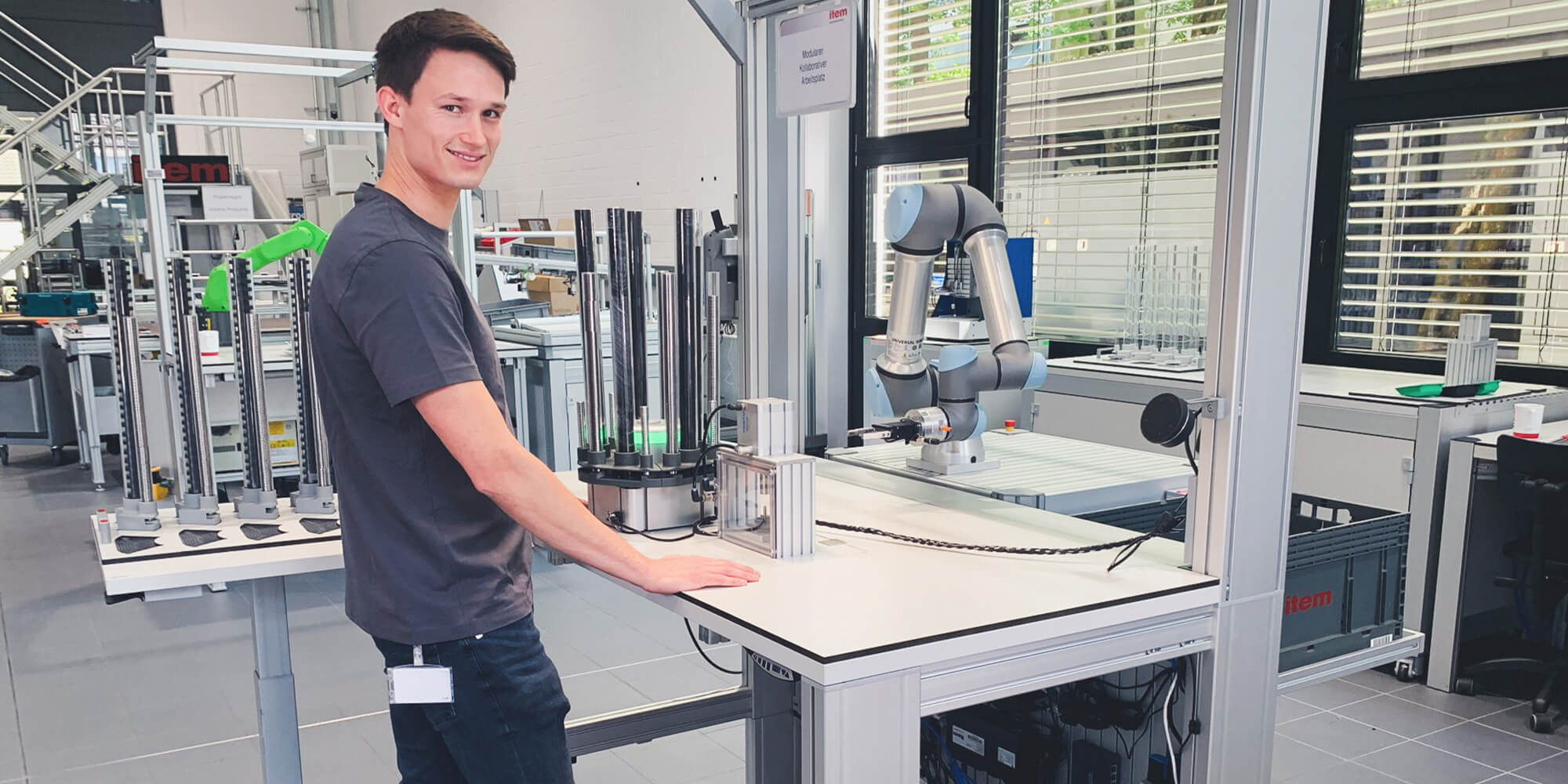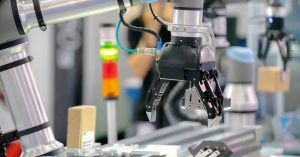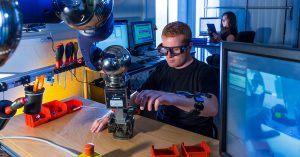item is benefiting from human-robot collaboration at the company’s European headquarters in Solingen by using “Cobra20”.
Collaborative robots (cobots) are in particular demand in manual assembly, where they interact closely with staff and can be integrated into a variety of industrial applications. The focus is on supporting their human colleagues as and where appropriate. Cobots offer a variety of benefits for large companies and SMEs alike. They don’t take up much space, for example, and can quickly be adapted to the relevant work requirements. Unlike traditional industrial robots, these agile assistants are specifically designed for human-robot collaboration – in a workspace shared with staff – without the need for a protective guard. How, though, do you achieve the ideal combination of human-robot collaboration and existing processes, and how do you get the message across to your staff that the robot solution helps them complete tasks more easily and efficiently? The example of introducing a cobot in the assembly area and the small-parts warehouse in Solingen illustrates how to go about this.
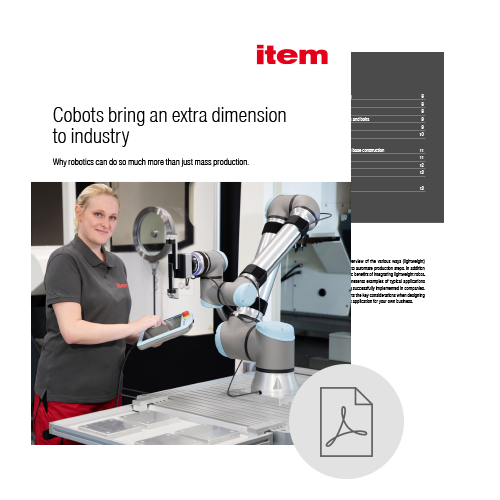
An overview of robot applications
Read our white paper to discover even more applications and advantages of robotics in industry – and why it’s a particularly worthwhile investment for SMEs, too.
Creating a semi-automated assembly process
As part of the continuous improvement process (CIP) at item, the decision was taken to use a robot application to make assembly processes at the company’s European headquarters leaner and partially automate them with the least possible outlay. The focus was on small parts assembly, an area where manual operations predominate. So, how exactly did we approach this project? It all started with a dedicated team testing and analysing the machining, picking and assembly processes. The entire process chain, the individual products and the systems being used were all examined. The team investigated what solutions were already available on the market and which ones were most suitable for optimising and automating the small parts assembly processes selected.
The lightweight robot was integrated into the existing working environment using the modular item building kit principle.
A lightweight robot from Universal Robots was used for the human-robot collaboration in this practical example. The solution is primarily intended for the production of small batch sizes. This highlights a key advantage of robotics for SMEs, whose production operations must regularly adapt to changing customer requirements. This particular example of collaborative assembly relates to a roller made up of several components. The manual assembly process previously involved fitting the components together one by one. The specific aim of using the collaborative robot assembly system was to ease the strain on staff. When implementing the project, it was possible to utilise item products such as ergonomic work benches and material supply trolleys. The lightweight robot was thus integrated into the existing working environment using the modular item building kit principle. A subsequent step involved attaching a workpiece carrier system in a separate functional cell.
Using a cobot to support staff
Previously, the individual roller components were unpacked in the small parts assembly section and placed in a number of containers before being joined together in a pneumatic assembly device. The cobot now does a large part of this work. Staff start by filling several magazines with the workpieces. The cobot takes the necessary individual parts and inserts them into the assembly device. Following automated assembly, the robot sorts the finished products, putting them into the workpiece carrier. Semi-automated production of three different types of rollers is therefore possible. The collaboration in this process is sporadic, with the robot doing around 90 percent of the work. Once the assembly device has been loaded and started, automated production means humans are only required for 10 percent of the process. The advantage of this is that while the cobot is working away, staff can focus on activities with greater value creation potential.
In this example, the human-robot collaboration is sporadic. Staff are spared monotonous tasks and can instead focus on activities with greater value creation potential.
Besides relieving the strain on personnel, this form of human-robot collaboration also offers further benefits. It saves on packaging material, for example, because the finished rollers are stored together directly on the workpiece carrier. Before this robotics application was introduced, a specific number of rollers would be packed in boxes. The cobot also takes care of counting – as soon as a predefined number of rollers have been assembled and the workpiece carrier is full, the cobot signals this using an optical aid. The full workpiece carriers are stacked in a crate, covered and placed in storage in the automated small-parts warehouse. In this example, a number of manual steps are thus eliminated thanks to human-robot collaboration. Similar options are available to SMEs, who can use human-robot collaboration specifically to improve their efficiency and employee satisfaction.
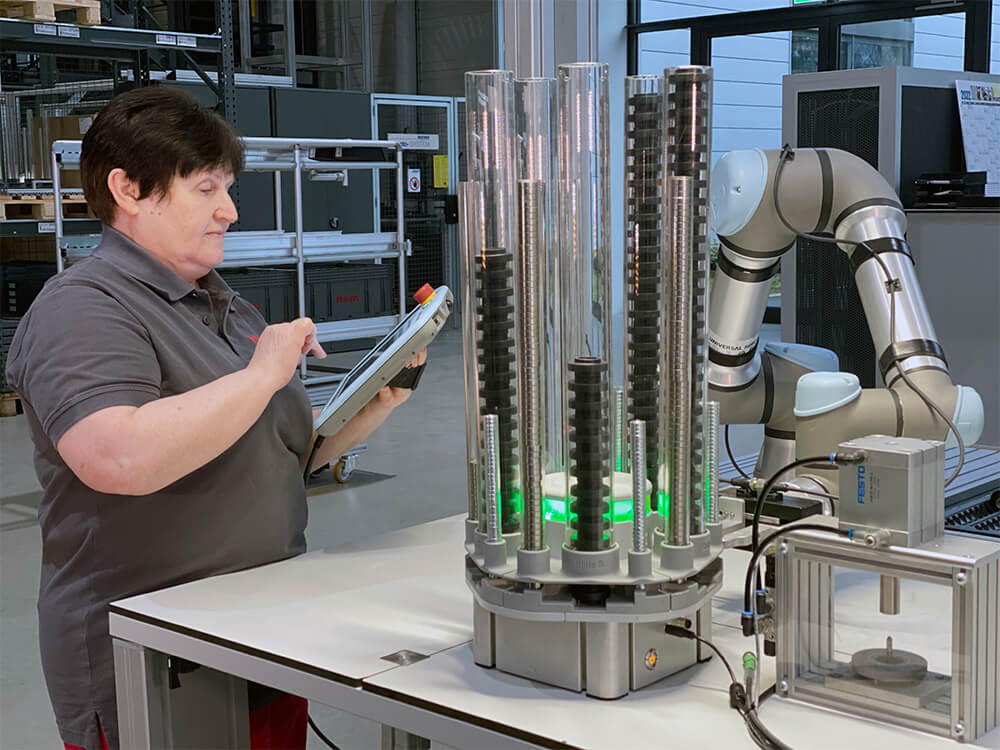
A practical example of human-robot collaboration
For the introduction of cobots to be a success, employees from across the various departments must be involved early on. In this example of human-robot collaboration, for instance, staff’s individual wishes and ideas were taken on board, and the project results were also presented transparently. “Full transparency from the outset and during implementation is an absolute must if you want to gain acceptance rather than face rejection. After all, the application works for staff, not against them,” explains Przemyslaw Krzysztyniak, a project and innovation manager at item. Employees thus use the cobot just like any normal tool or piece of equipment and set the pace they want to work at.
The introduction of the new technology completely wowed everyone. We created a better working atmosphere and the cobot became part of the team.
Easy, intuitive operation was deemed vitally important in order to ensure the entire small parts assembly team can operate the cobot independently. The response of employees to their cobot colleague was extremely positive from the outset. “The introduction of the new technology completely wowed everyone. We created a better working atmosphere and the cobot became part of the team,” reveals Nasim Mahek, a control station operator from this team. Staff gave the cobot the catchy name “Cobra20” because of its snake-like features and the year it was introduced.
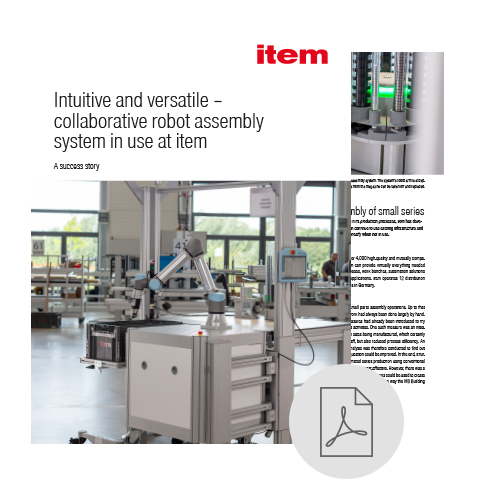
Human-robot collaboration in assembly
A collaborative robot assembly system in use at item can be operated without special knowledge and implemented using existing infrastructure. Find out more about the benefits of these systems, how to implement them and the response of staff members.
READ THE USER REPORT
Collaborative robot assembly system – a flexible solution
Besides the personnel and the equipment used, economic aspects also have a decisive impact on successful cobot integration. This is where the modular approach that runs through the entire item portfolio comes into its own. Cobra20 is destined to be utilised not just for one single assembly process, but for the production of multiple products. One way of achieving this is to use the versatile grippers of the Zimmer Group. Following a short setup process, the cobot can then perform tasks such as screw-fixing applications, and can thus make components from three different product groups.
The collaborative robot assembly system from item is a flexible solution that can be docked onto the relevant work benches entirely as required.
The collaborative robot assembly system was designed as anything but an isolated, permanently fixed system – it’s a flexible solution that can be docked onto the relevant work benches as required. Safety aspects such as Machinery Directive 2006/42/EC, and various standards and technical specifications such as DIN ISO/TS 15066, were also taken into account in this project. In terms of safety, this solution is a prime example of human-robot collaboration, because the cobot is integrated into the working environment in a way that virtually rules out any accidental contact with people. Virtual guards provide additional safety – if the robot arm moves outside the defined work area, the movement is automatically braked.
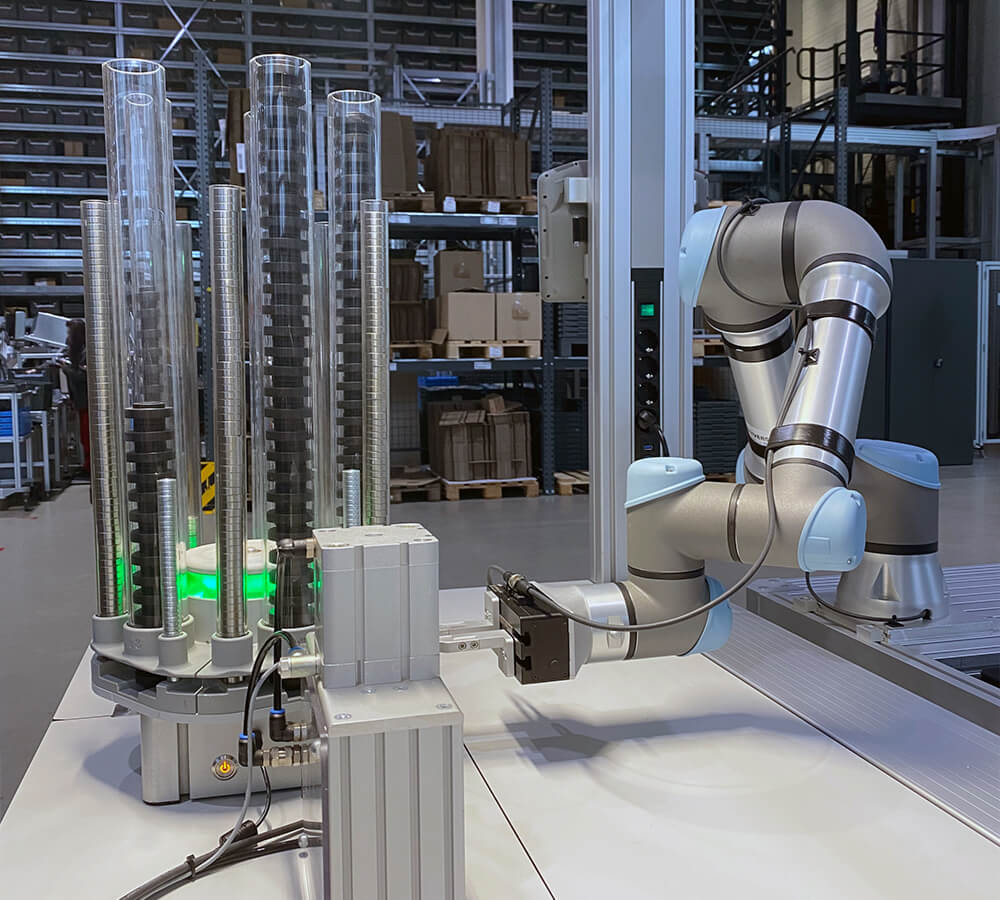
If you want all the latest updates on innovative robotics applications, simply subscribe to the item blog by completing the box at the top right!

